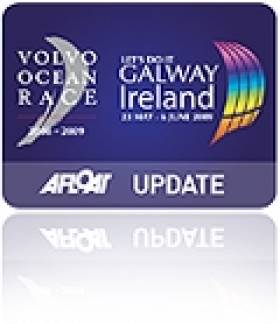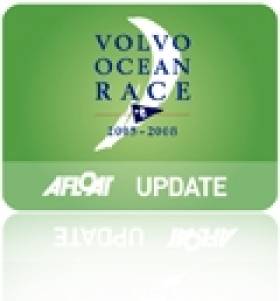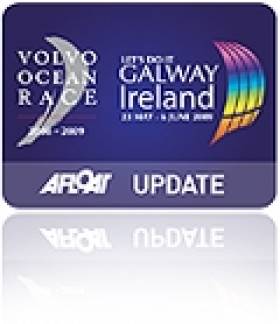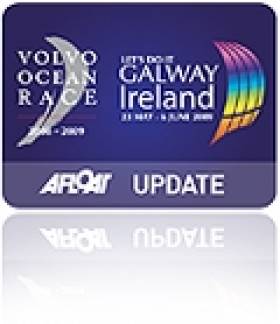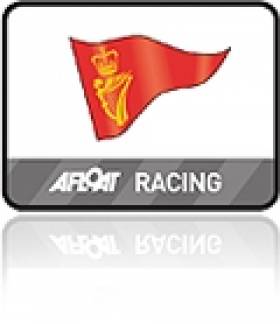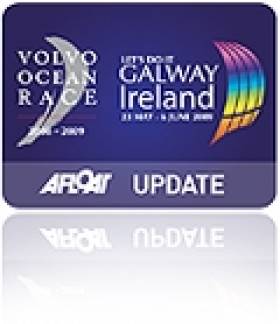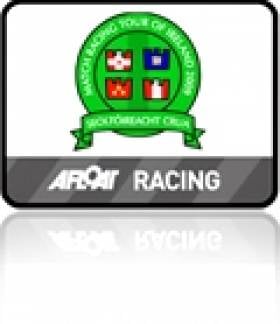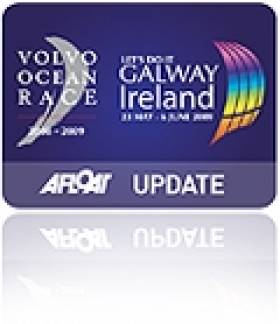Displaying items by tag: race
Marine Minister Showcases Galway at Volvo Race Start
#VOLVO OCEAN RACE – As the Volvo Ocean Race 2011-2012 kicks off tomorrow (5 November) from Alicante in Spain, Minister for Agriculture, Marine and Food Simon Coveney TD joined Tourism Ireland today, at a reception for key Spanish and international media contacts. As previously reported by Afloat.ie this week the event, which took place in the Volvo Ocean Race Village in Alicante, was an excellent opportunity to showcase Galway and Ireland as a fantastic holiday destination, kicking off Tourism Ireland's publicity drive around the world during the nine-month race to reach a huge audience of potential holidaymakers.
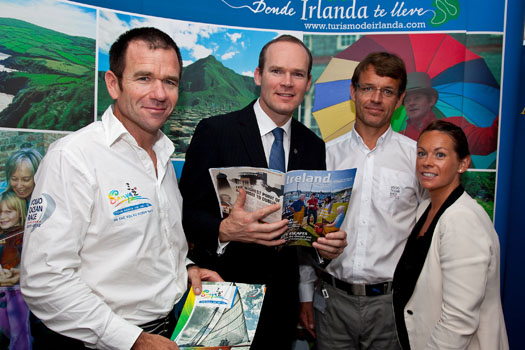
Mike Sanderson, skipper of Team Sanya, the Chinese/Irish boat; Simon Coveney TD, Minister for Agriculture, Marine and Food; Knut Frostad, CEO of the Volvo Ocean Race; and Barbara Wood, Tourism Ireland's manager in Spain, at the Tourism Ireland reception in Alicante, prior to the departure of the Volvo Ocean Race 2011-12 tomorrow
The Volvo Ocean Race attracts huge publicity around the world – with billions of people around the globe seeing it on TV, reading about it and tuning in to hear about it on the radio. Over the coming months, Tourism Ireland will be working in key markets where the race stops, to ensure that Galway and Ireland are in the spotlight.
Niall Gibbons said: "The Volvo Ocean Race attracts huge publicity around the world and with Galway due to host the grand finale, there's an ideal opportunity to showcase Galway and the west, and the many attractions that the island of Ireland has to offer as a holiday destination. The event is a great 'hook' for Tourism Ireland to reach a huge audience of potential holidaymakers."
Galway will host the final stopover of the Volvo Ocean Race 2011-2012 in July of next year. The 2009 stopover of the Volvo Ocean Race in Galway brought 40,500 international visitors to the city, as well as 269 journalists from around the world.
Galway Hooker En Route to Abu Dhabi in VOR Cultural Exchange
A traditional Irish sailing boat is on the way to Abu Dhabi in a cultural exchange that will also see six Arabian dhows in Galway for the finish of the Volvo Ocean Race next summer.
The National reports that the near-century-old Galway hooker Nora Bheag is being transported to the United Arab Emirates as part of a Maritime Heritage Cultural Exchange initiative, co-ordinated by Irish expat Peter Vine. (Track its progress at marinetraffic.com.)

On her way: Nora Bheag heads for Abu Dhabi. Photo: Boyd Challenger
According to the Galway Independent, the boat is currently en route to Rotterdam in a container loaded with a small curach named Noa.
Plans to include turf and bottles of poitin were abandoned, however, due to customs concerns - instead two hurleys and a sliotar will make the trip.
Nora Bheag is expected to reach port by early December ahead of the Volvo Ocean Race fleet which arrives on 1 January, marking the first time the city has hosted and taken part in the race.
Vine says he came up with the idea of the boat swap because of the two countries' shared maritime heritage.
There are many similarities between hookers and dhows, too, from their comparable sail shapes to their usage for fishing and personal transport.
"This will be a huge common shared experience that will build true friendships and a real cultural exchange," said Vine. "I am hugely grateful to Emirates Heritage Club, which has done so much to revive Arabian dhows, for making such a project possible."
The National has more on the story HERE.
Meanwhile a delegation from Galway is set to travel to Spain later this week for the launch of the Volvo Ocean Race.
A week of events begins this Saturday ahead of the start of the race proper on 5 November in Alicante.
New Media Man Announced for Discover Ireland Backed VOR Entry
Team Sanya, the Chinese - Irish backed entry in the 2011/12 Volvo Ocean Race, announced today that Andres Soriano (ESP/USA) is to take on the role of their Media Crew Member.
There has been some disappointment at home given the only Irish crew member on board the boat was Frankie Leonard who withdrew over seasickness in late September. Subsequent applications for the media post included Irish sailors who it now appears were unsuccessful in their quest to join Mike Sanderson on the Sanya boat, 25% funded by Discover Ireland.
Andres started working with Team Sanya as part of the Shore Team back in August 2011 when the team was based in the UK. Since then he has developed a close fit with the team and has gained a detailed understanding of the team objectives as well as the workings of the race boat. These facts, combined with Andres' media background and
experience, puts him in a perfect position to take on this role and deliver great results for the team and the event.
Mike Sanderson, CEO/Skipper for Team Sanya, commented on today's announcement:
" Since day one, Andres has fitted in perfectly with our team spirit and personality. He is an incredibly hard worker and has turned his hand to anything we have thrown at him, which has won him enormous respect from the guys. He has the right balance of media skills and creativity coupled with offshore sailing experience and so I have high hopes for his ability to tell the Team Sanya story to the outside world in a dynamic and unique manner." Andres Soriano, new Media Crew Member for Team Sanya, gave his reaction
to his new role:
"I am truly ecstatic and excited about my role as media crew member. I know it will be one hell of a ride and I consider myself very lucky to be a part of this awesome Team Sanya race crew. We have already built up a keen fan base and I will definitely take on the challenge to expand that by telling our story in an insightful way never seen before."
Andres Soriano Biography details:
Date of Birth : March 26th 1986
Nationality : Spanish American
Resident : Manila, Philippines/New York, USA
Derry-Londonderry Fifth in Clipper Leg Three
Derry-Londonderry, one of the ten international teams competing in the Clipper 11-12 Round the World Yacht Race, has won the fight for fifth place in Race 3 of the 15-race series in a contest that went right down to the wire. As they closed in on the finish line in Cape Town, Derry-Londonderry and Qingdao were matching each other mile for mile with Welcome to Yorkshire and New York hot on their heels. At the line there was just five minutes and eleven seconds between the two teams after 3,300 miles of racing.
The 68-foot ocean racing yacht representing the UK City of Culture 2013 crossed the finish line in Table Bay against the magnificent backdrop of Table Mountain at 0505 local time on Thursday morning (0305 UTC) while Qingdao crossed at 0510 (0310 UTC). Race 3 was won by Gold Coast Australia, who completed a hat trick of victories so far in Clipper 11-12, with Visit Finland in second place and De Lage Landen in third.
Arriving in the V&A Waterfront, Derry-Londonderry skipper, Mark Light, said, "It was touch and go – a great finish. Qingdao crossed in front of us and then they had to gybe but we didn't have to. They crossed probably 200 metres in front of us and we were waiting and waiting for the gybe which didn't come and all of a sudden we cut inside of them and managed to take them in the last 0.8 of a mile. It was amazing.
"We were disappointed initially not to get fourth but that quickly disappeared because we were massively happy to get fifth place."
Qingdao's skipper, Ian Conchie, said, "It's been a duel all the way in up until the last six hours when we got ahead of them. In very light airs we found yet another wind hole as we approached Cape Town and then on the final gybe, less than a mile from the finish, the wind shifted on us which meant we could no longer hold the kite and they just sneaked in front of us. We were 50 metres off the beach – it was exhilarating stuff after 3,300 miles."
During the race the crews, who come from all walks of life and between them represent more than 40 nationalities, faced mountainous seas and strong headwinds.
Shauna O'Neill is one of the five Derry City Clipper Bursary winners. The bursary is a project designed to help unemployed people in the city learn the skills to get them back into work. The five will also carry out ambassadorial roles to help promote Derry-Londonderry as the City of Culture, each focussing on an area including, digital, young people and enterprise.
Arriving in Cape Town, where her mother was waiting to greet her on the dock, Shauna said, "The tough weather was exciting. I wasn't really in control of anything so I felt quite safe but I'd say it was hard for the watch leaders. There were some big waves and it was scary enough but we got through it.
"I absolutely loved it, every moment of it. I worried before I went away that I was going to hate it but it's just been amazing, I loved every bit. There have been so many best bits – navigating with the stars at night, helming with the sunrise, everybody on board, how friendly everyone was... all of it!
"It was nothing like what I expected. When I first heard about it I was imagining sailing around in luxury. It was really tough but the training was the hardest and the actual leg was so much fun."
During the stopover in Cape Town the crews will visit many of the attractions the city has to offer including taking the cable car to the top of Table Mountain, the beautiful botanic gardens at Kirstenbosch, and Cape Point which the teams will see from the ocean as they round the Cape of Good Hope in the next race to Geraldton in Western Australia.
Alongside the stopover a busy international trade programme is scheduled with delegations from Derry-Londonderry and many of the other team sponsors, partners and official suppliers to the Clipper Race visiting Cape Town to forge partnerships with local businesses, generating international trade opportunities and developing cultural links.
Race 4 to the City of Geraldton, Western Australia, will start on Wednesday 5 October.
The Clipper 11-12 Race started from Southampton on the south coast of England on 31 July. It runs every two years and is the only event in the world where people from all walks of life can take on the challenge of a lifetime and race around the globe on stripped down ocean racing yachts. Berths are now available for Clipper 13-14, which will see the introduction of a brand new fleet of twelve 70-foot yachts.
Sea Sickness Rules Irish Sailor Out of World Race
Galway sailor Frankie Leonard is stepping down as Team Sanya's media crew-member following a bout of seasickness in the recent 2,000-mile qualifying passage for the Volvo Ocean Race (VOR).
The team Sanya entry is a Chinese-Irish entry in the race that starts in November from Alicante. Tourism body Discover Ireland are backing the boat and making up 25% of its estimated €10 milion campaign costs. Leonard was the only Irish crew member on the boat that is under Kiwi skipper Mike Sanderson, a former race winner. The boat, one of seven entries, is expected at the race finish in Gawlay next July.
A statement yesterday described the development as a "cruel blow" to both Leonard and the campaign and paid tribute to the cameraman's commitment and contribution.
Much of the MCM role is dependent on being below decks for extended periods, either working in the tight confines or at the galley preparing the freeze-dried food for the crew and is a mandatory position within every team. The team statement is below.
23rd Sept 2011
Mike Sanderson, Team Sanya CEO and Skipper, announced yesterday with regret a change to the media crew member role following a decision to release Frankie Leonard from his duties. Frankie, who has been engaged with the team since the beginning of the project, unfortunately has suffered from seasickness, which affects a great many sailors.
Mike Sanderson commented:
" Frankie has all of the ideal qualities to fit this role - superb teamwork and communication skills, a dynamic approach to his film and photo work combined with a great sense of humour and a pleasure to be around. However, this race is all about performance on the water and Frankie's suffering from seasickness is a cruel blow both to the team and to him. As anyone who been struck down by seasickness knows well, it can leave you incapable of functioning to your normal levels. We have 37,000 miles of ocean to cover and sadly that left me with no option in this matter.
Frankie has made a great contribution to the team and made many new friends in the time he has been here and we will be keeping in touch for sure."
Frankie Leonard added his thoughts:
"It has been an amazing opportunity to be a part of this special team and a great experience both personally and professionally. I am happy to say that I leave with no regrets. It is always unfortunate when things come to an end but rather than dwell on negatives I prefer to accentuate positives. Team Sanya has had one of the highest media outputs of all the teams with almost double some teams output for video, blogs and photos. We have steadily built up good relationships with the media, our sponsors and Volvo Ocean Race HQ, which can only be a positive for the team. I know that the skills, knowledge and experience I have acquired will stand to me as I now go in search of new projects. I am glad to count Mike and my teammates as good friends now and I wish Team Sanya a safe, happy and fast race."
Brisk Sailing for Royal Cork's Naval Race (Photos here)
There was a great sailing breeze for today's Royal Cork Naval Race in Cork harbour and the appearance of the Navy's own Sail Training Yacht Creidne added to the occasion at Haulbowline writes Claire Bateman. Scroll down for photos.
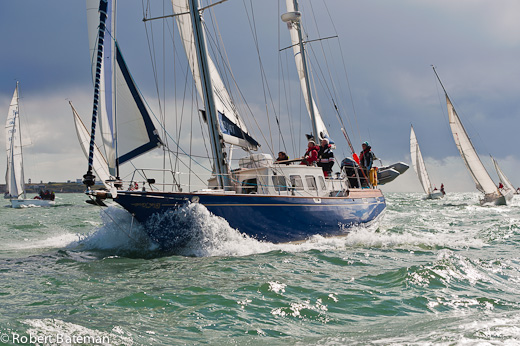
The Defence Forces STY Creidne shows her pace in Cork Harbour in today's Royal Cork Yacht Club Naval Race. Photo: Bob Bateman. More photos below
The second fleet to start, comprising of Classes Three, Four and White Sail Class that included many Class One boats, were given a reaching start in the harbour into Corkbeg, a beat across to Cage, a run back to Corkbeg, a reach in the harbour and a beat to the finish before arriving at the Naval Base.
For this scribe the highlight of the event was to watch the Creidne with her gleaming blue topsides joust with Táilte. Creidne being a bigger boat with a longer waterline and ketch rig had the legs on Táilte on the reach but Táilte was pointing higher on the beat, had more manoeuverability and got ahead at Cage. On the reach back to Corkbeg Creidne again showed her speed to round Corkbeg just behind Táilte. It was great sailing and well done to both crews and their helmsMeanwhile in Class Three the Jimmy Nyhan/Maritta Buwalda Outrigger was making all the running and were using their asymmetric spinnaker to good effect and despite the best efforts of the J24 and the Impalas they couldn't catch them.
The conditions were such that the white sail boats were having a ball but as the fleet were rounding the Spit Bank a squall struck and took away some of the pleasure. However, it was soon to clear before the merry band arrived at the Naval Base to enjoy well earned and most generous hospitality provided by the Naval Service.
Dublin to Hamble in 24 Hours - Team Sanya's Video
One minute it's trips round the bay with Miss World, canapés at the Royal Irish Yacht Club and corporate hobnobbing in Dun Laoghaire. The next it's a wet and windy ride from Dublin to Hamble in 24 hours. It's the lot of the modern Volvo Ocean Race crew (helmets compulsory). Chinese-Irish race entry Team Sanya boss Mike Sanderson (a previous race winner) has called his exit from Dublin 'heinous'. Don't take our word for it tho, check his vid below:
World's Top Match Racers Compete in Nations Cup Final
Hosted by Sail Sheboygan, the competition will see some of the finest sailors from across the globe mixing it up along the Lake Michigan shore in identical one-design class sailboats for this culmination of a series of eight match racing regattas that started in Porto Alegre, Brazil, on 24 March.
The ISAF Nations Cup is a global competition to find the world's top match racing nation in open and women's events, while also promoting and developing the sport of match racing in sailing, which pits one boat against another. Gaining popularity, women's match racing will make its debut as an Olympic Sailing event for the 2012 Olympic Games in London. The 2011 Nations Cup included seven regional finals, from which the top teams will compete in Sheboygan. The Grand Final will be sailed in the Sonar class for the open event and the Elliott 6m for the women's event.
Ten teams will compete in the women's event, and ten entries have been confirmed in the open event. In the women's event, two-time defending champion and number one ISAF ranked women's match racing skipper and #4 in the world, Claire Leroy (FRA) and her crew will go up against the American team led by Genny Tulloch, ranked #11, and Olympic medallist Mandy Mulder of the Netherlands, ranked #17. Further competition is expected from the Brazilian team led by Nations Cup veteran Juliana Senfft.
The open event will see American Shawn Bennett and his crew of Dave Perry and Craig Healy take on the Danish team led by Mads Ebler, ranked #8 in the ISAF open match racing division rankings, and New Zealand match racing winner Laurie Jury and his team. Racing for Poland will be three-time Polish match racing champion Przemek Tarnacki. Teams representing Australia, Great Britain, South Africa, France, China, Pakistan, Greece, Turkey and Canada will also be sailing for the cup.
Antonio González De Le Madrid, ISAF Competitions Manager, said, "We are delighted that some of the world's best match racers will be making the trip to Sheboygan for the ISAF Nations Cup. There are some very experienced sailors lining up alongside those who are in the early stages of their development. Nonetheless it should make for a fantastic few days of match racing action."
According to Sail Sheboygan's, Executive Director, Rich Reichelsdorfer, said, "Sail Sheboygan is excited and honored to be hosting the Grand Final of the Nations Cup. We have assembled a top-class race management team backed up by a dedicated corps of volunteers for this premiere match-racing event and we can't wait to show the world our facility. With dozens of the best match-racing sailors in the world coming to Sheboygan, the ISAF Nations Cup will be a spectacle to be enjoyed both by sailors and spectators alike. The racing is sure to be fast and furious and the onshore activities will be equally fun."
A non-profit organization, Sail Sheboygan, was formed in 2004 to promote national and international sailing competition and education. As one of only four US Sailing Centers, its mission is to develop sailing and seamanship at all levels, regardless of age, income, ability or disability.
Team Echo Win Dublin Match Race Event
After a three round robin series organised by Howth Yacht Club, visting Team Echo, from Poole in Dorest, won Dublin's 2011 Match Racing Open. The team made up of Mark Lees, Toby Yeabsley, Mark Yeabsley and Peter Austin convincingly won the Investwise sponsored series, sailed in J80s with 11 wins and one loss.
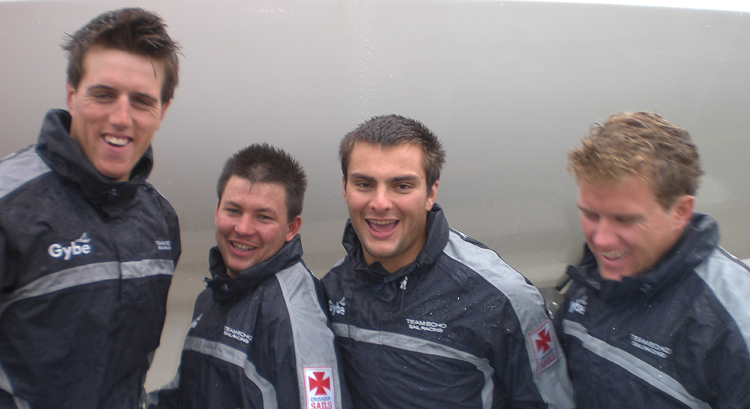
Team Echo won the Dublin Match Racing Open
In the second race an unfortunate incident where bowman Peter Austin cut his leg disrupted the usual momentum of the team. an Irish Match racer kindly stepped in as a substitute for the remainder of racing one the first day and regular mainsheet trimmer Toby Yeabsley stepped in as bowman while Peter went to be treated in hospital.
A tie break was required to split the home clubs team - consisting of evelopment squad members skippered by Ryan Scott - from Peter Bayly and Team PN, with the HYC Development Squad taking second 2 wins to 1. Peter showed glimpses of what he can do, the only skipper to take a race form the British team.
Alistair Kissane and Team Pies finished fourth and Audrey Adamson with SailingWest Ladies finished fifth.

Rosanna Davison Goes Sailing on Team Sanya (Pics here!)
Former Miss World Rosanna Davison went sailing from Dun Laoghaire today on board the Chinese Volvo Ocean Race Yacht, Team Sanya. The yacht has backing from discover Ireland and is on a promotional day before departing for Alicante and next month's race start. Kiwi Skipper Mike Sanderson showed the local girl the ropes and Photographer Michael Chester sent Afloat.ie back these photos from the high speed spin around Dublin Bay.
Skipper and past race winner Mike Sanderson and his crew - including Galway’s Frankie Leonard – received a special send-off from Rosanna who won her Miss World title in the Chinese city of Sanya in 2003.
Team Sanya is the Chinese entry in the 2011-12 Volvo Ocean Race, a 40,000-mile round the world race that will finish in Galway on the 3rd July 2012. A special relationship developed between Ireland and China during the last race through the Green Dragon entry.
Rosanna boarded the yacht at 11.00am at the Royal Irish Yacht Club and sailed with the team into Dublin Port. The Eastlink bridge was lifted at 2.00pm, and Team Sanya docked beside the Cill Airne.
As part of the team’s promotion and it’s Irish link through the Discover Ireland.com, the 70 foot race boat and crew will head back out into the open sea as they start their journey to Alicante for the race start on the 5th November.
The Volvo Ocean Race is regarded as sailing’s premier global race and one of the most demanding team sports in the world. The 2011-2012 Volvo Ocean Race route is: departing on 5th November from Alicante to Cape Town (South Africa) Abu Dhabi (UAE) Sanya (China) Auckland (New Zealand) Itajai (Brazil) Miami (USA) Lisbon (Portugal) Lorient (Framce) and finally Galway on the 3rd July 2012.
Mike Sanderson, skipper and CEO of Team Sanya commented on the forthcoming trip: “Our relationship with Ireland is really important to us. Frankie Leonard from Galway is our media crew member and he is going to be paramount in telling our story as we race around the world, building the profile of Ireland as the stunning tourist destination that it is. For many of our team, it is our first time visiting Ireland so we were really happy to include a pitstop in Dublin during one of our training trips.”
Frankie Leonard, Team Sanya race team and the Irish Media Crew Member, added: “As the only Irishman on board I’m very proud to be part of this exciting event with Team Sanya and really looking forward to sailing into Dublin next week. My home town is Galway and finishing there in July 2012 is going to be a very special moment but this stop-over is a perfect way to help build a strong following and fan base in Ireland to develop Ireland’s profile as we travel to nine other ports around the world.”

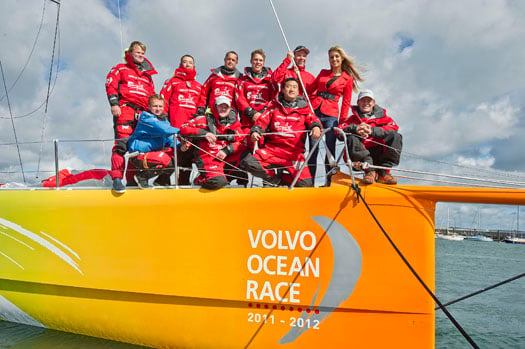
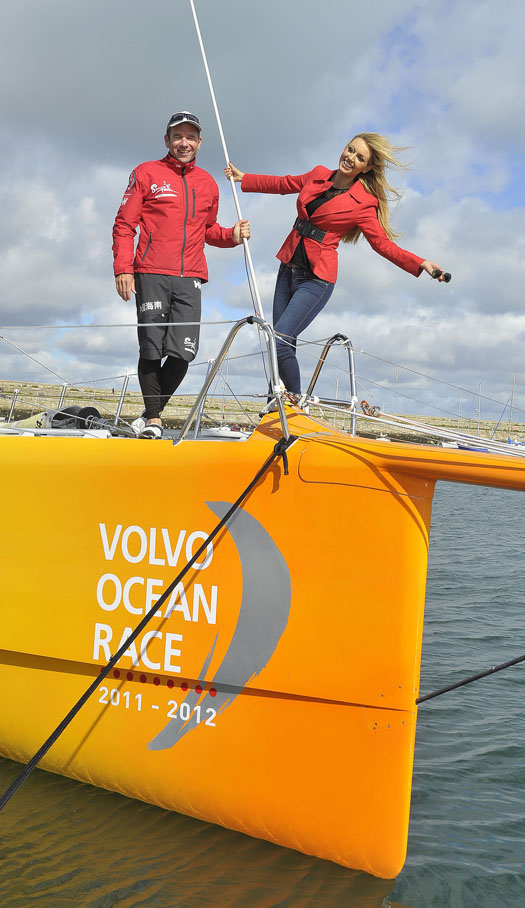

More shots of Team Sanya on Dublin Bay today (by Gareth Craig) here


























